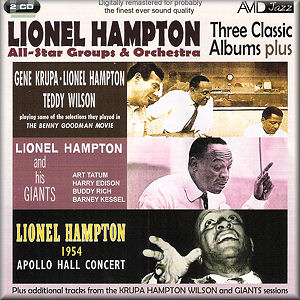CD1
Gene Krupa, Lionel Hampton, Teddy Wilson
1. Avalon
2. Just You, Just Me
3. Blues for Benny
4. I Got Rhythm
5. Moonglow
6. Airmail Special
The Genius Of Lionel Hampton
7. The Man I Love
8. Body And Soul
Lionel Hampton & his Giants
9. Plaid
10. Somebody Loves Me
11. Deep Purple
CD2
Lionel Hampton & his Giants
1. September Song
2. Verve Blues
The Genius Of Lionel Hampton
3. What Is This Thing Called Love?
1954 Apollo Hall Concert
4. How High the Moon
5. Stardust
6. Lover Man
7. Midnight Sun
8. Love is Here to Stay
9. The Nearness of You
10. Vibe Boogie
11. Flying Home
Lionel Hampton & the Giants session
12. September Song (78 rpm version)
13. What Is This Thing Called Love? (Alternate take)
Dreams do come true. For years I have hoped that, one day, Lionel
Hampton's Apollo Hall concert would be released on CD, as my LP of
the concert is virtually worn out. That lucky day has arrived with
this compilation which contains Apollo Hall and, among other riches,
the classic session that Hamp recorded in 1955 with a line-up that
included Art Tatum and Harry Edison.
Lionel Hampton has always been one of my favourite musicians - not
only for his ability to make almost any number swing but also for
his evident pleasure in playing, which is often underlined by grunts
and shouts of approval or encouraging his fellow musicians to play
just one more chorus. Add to this the way that his solos always
seem to suggest the structure of the tune he is playing.
This rather disorderly collection on a double CD starts with recordings
which suggest what the Benny Goodman Quartet might have sounded like
if Benny had been absent. In fact the group here is a quartet,
as Red Callender is brought in on double bass to help the rhythm along.
In the original Goodman trio and quartet, the rhythm was handled quite
adequately by Gene Krupa's drums, but here Gene's contribution seems
to be under-recorded, except when he is playing a solo.
We are reminded of Benny Goodman as the group ends Avalon
with the riff that Goodman used on this tune. Teddy Wilson's piano
adds touches of elegance to Hampton's more down-to-earth playing.
Teddy's solo on Just You, Just Me shows how he used left-hand
chords and syncopations to back up (or contrast with) what his right
hand was playing. My only complaint is that Hamp was clearly enjoying
himself so much that some of his solos tend to go on a bit too long.
But his good humour is clear in such things as his quotation from
Carry Me Back to Old Virginny in Blues for Benny. Rather
confusingly, tracks 7 and 8 are by the same group but they come from
an album called The Genius of Lionel Hampton. Hamp's theme
statements of these two tunes prove that he could be a sensitive ballad
player as well as an invigorating swinger.
The next five tracks come from the LP Lionel Hampton and his Giants
- and giants they certainly were. Alongside Hampton there is the unsurpassable
piano of Art Tatum and the melodiously economical trumpet of Harry
Edison, underpinned by the bass of Red Callender or John Simmons and
the responsive drums of Buddy Rich. Guitarist Barney Kessel is added
for three tracks. The opening track is Plaid, one of my all-time
favourite Hampton recordings, with a catchy melody as well as unstoppable
propulsion. Art Tatum displays how he can swing despite all those
florid arpeggios for which he was famous (or notorious). This sextet
was the largest band that Tatum ever played for - probably because
he tended to dominate every group he was in. Certainly it must have
been difficult for Lionel Hampton to play something like Deep Purple
when Tatum was virtually duplicating the melody behind him. The high-speed
What is This Thing Called Love? comes from the same session
but a different LP. It includes some admirably integrated drum breaks
from Buddy Rich.
Then comes the Apollo Hall concert, recorded at Dusseldorf in November
1954 by Hamp's big band, which boasted such notable musicians as Bobby
Plater, Nat Adderley, Buster Cooper and Wallace Davenport. Lionel
introduces the concert with a mischievous How High the Moon,
backed by a rhythm section in which Hamp's long-time guitarist Billy
Mackel is prominent.
The best-known track from the album, Stardust, was actually
not recorded at Dusseldorf but in Amsterdam the week before. It is
a superb example of Hamp's inventiveness and technical skill on the
vibraphone. It is also a typical Hampton performance in continually
going into double time, which is accentuated by the steady slow beat
maintained by the rhythm section. There is also a lovely saxophone
feature in Lover Man and one of Hampton's finest compositions:
the gloriously chromatic Midnight Sun. Of course, the concert
has to end with Flying Home, Hamp's customary crowd-rousing
closer.
This generous compilation ends with two alternate takes from the
session with Tatum and Edison: a gentle September Song and
a slightly ragged What is This Thing Called Love? All these
recordings from the mid-fifties capture Lionel Hampton at the height
of his powers, surrounded by marvellous colleagues. This is not only
my nomination for Bargain of the Year but also for Album of the Year.
Tony Augarde
